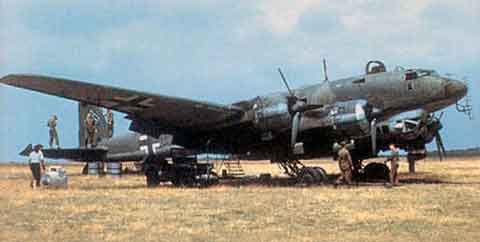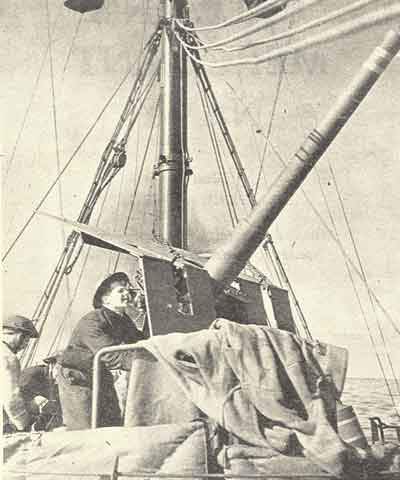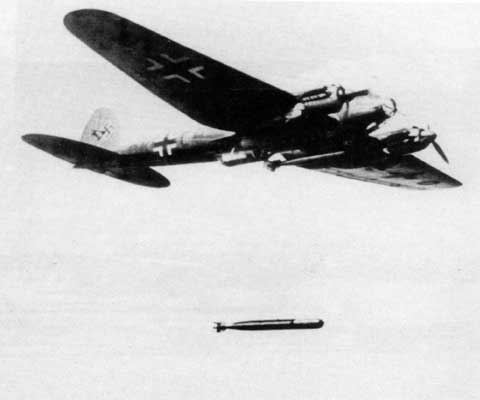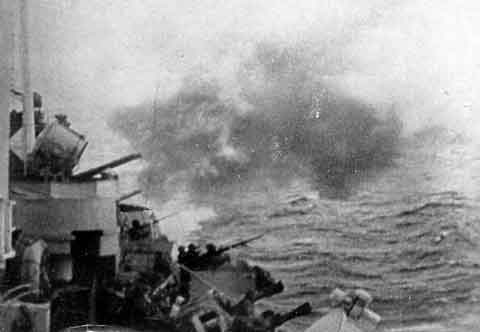Major P. Pettit – 17th Field Regiment Cameronia:
“At 2230 Bill and I were on deck, we heard an aircraft coming nearer, it seemed to swoop on the ship and away again. As it came in our AA opened up with tracer and as it went away the other boats opened up as well. Really a ‘Brocks Benefit’ (a wartime expression meaning a ‘Night Bombardment’ named after a well known British firework manufacturer of the time – ‘Brocks’). Then the alarm bells rang for ‘Action Stations’ and we went below to our jobs on the troops messdecks”
In the words of Master of the Cameronia Captain Kelly, in his ‘Shipping Casualty Report’:
“At about 2230, when just leaving the swept channel, an attack was made upon us by three Heinkels 111 and (The five) Junkers 88 bombers. ‘Action Stations’ were sounded, and a heavy barrage put up by ourselves and the Escort”
Lt. P. Royle – Royal Artillery Cameronia:
“The alarm bells sounded and the performance of the previous night was repeated”
George Chadwick – Steward Cameronia:
“10.30p.m. ‘Action Stations’ sounded. We put up a terrific barrage from the ship”
Immediately “Action Stations” were sounded, troops throughout the ship got out of their hammocks and stowed them away to clear a path should one be required for rapid abandonment of the ship.
Richard Day – The Rifle Brigade Cameronia:
“As we were below deck we obviously couldn’t see what was going but we could hear the ship’s Anti-Aircraft guns firing and the sound and vibration was causing dirt and dust from the ceiling to fall all around us”
Elsewhere onboard the Cameronia Eric Halford witnessed what turned out to be a morale boosting incident.
Eric Halford – Royal Army Service Corps Cameronia:
“During the attack one soldier ran for the stairs shouting that they would ‘All be killed like rats in a trap’. The Officer shouted ‘Silence that man !’ and Sergeant Val Stokes knocked him pretty well unconscious with one blow to the jaw. The soldier that was hit was of Jewish origin and had been a tailor in Civi street and did work for his fellow soldiers but was unpopular because of the way he charged for his work so the way he was dealt with raised a cheer !”
This recollection together with Lieutenant Royle’s (see below) serves to demonstrate that at least onboard the Cameronia, although Officers quarters were separate from the men, during an attack, several Officers were tasked with the job of going into the men’s quarters to try to maintain calm and otherwise prevent potential incidents of panic which would have become infectious.
Lt P. Royle – Royal Artillery Cameronia:
“Our CO had also given instructions that at least two Officers from each Battery should be down on the messdecks if the alarm sounded”
Captain D.W. Bone – Circassia:
“Although reasonably well informed in the theory of defence by evasive action against attack by torpedo bombers we had not been practised and only a few of our DEMS Gunners had done more than loose off a round or two at a towed sleeve target”
The Gunners of the Circassia were now faced with four attacking torpedo bombers.
Captain D.W. Bone – Circassia:
“Upon sighting the four planes of the enemy as they came roaring in on their runs, we opened fire too soon and in consequence the Oerlikon drums were empty of shell when the two aircraft on our port beam closed in within effective range. But adequate defence in our novitiate was quickly provided. A neighbouring ship on our port bow that subsequently we made out to be a Fleet Destroyer suddenly turned towards the enemy spitting out a vicious stream of fire that had the effect to disrupt the airmen’s aim or to discourage his attempt; we saw the track of one torpedo cross the bow as we ported helm to correspond with the warship’s action”
The “Fleet Destroyer” was the Light Cruiser HMS Aurora whose Navigator’s Log book made the following note:
“2220 Attacks by torpedo bombers commenced. Zig-zagged astern of convoy, opened fire on seen targets and on RDF contacts closing. Heinkel 111s dropped two torpedoes each”
HMS Scylla also reported opening fire on enemy aircraft, a Ju 88 A-4 at 2225 and then at another torpedo bomber at 2247
Oberbefehlshaber Süd (OBS) Report No. 389 – Axis Report (Italian) attacks of the 21st:
“Anti-Aircraft fire heavy, accurate”
Captain G.B. Kelly – Cameronia:
“The attack was eventually beaten off without any of us being damaged. As I swung the ship tostarboard a torpedo missed and passed close along the port side”
Austen Parker – Royal Signal Corps Cameronia:
“An enemy aircraft released two torpedoes at us which narrowly missed”
Jim Lafferty – Steward Cameronia:
“Wave after wave of torpedo bombers swooped in to attack us and time after time we evaded their torpedoes only by skilful and quick action on the helm”
Major P. Pettit – 17th Field Regiment Cameronia:
“During the first alarm we had had a concert on the messdeck, someone had a piano accordion and one or two songs. One I remember particularly, a boy with a pale face, short not robust and not a strong voice, but he sang the ‘Rose of Tralee’ accompanied by the accordion and AA gunfire very steadily and got a real round of applause”
As the ‘All Clear’ had not yet been sounded, no hammocks could be put back up, not that fear and adrenalin filled soldiers were going to be capable of luxuries such as sleep, so the impromptu concert continued.
Major P. Pettit – 17th Field Regiment Cameronia:
“The accordion player did a solo turn, he hesitated at a couple of extra large explosions but I said ‘They were our AA guns’ and he went full steam ahead. (They were too – I guessed right for once)”
In the meantime, the attacking aircraft having dropped their ordnance departed the convoy and returned to their prepared landing field in Elmas (landing at 0100) ending the first attack on this combined KMF-5/TE-10 convoy.
Major P. Pettit – 17th Field Regiment Cameronia:
“Nothing else happened and I went to sleep on a row of rolled hammocks by the companionway”
Axis accounts of this first attack state that it took place north of the Algerian coastal town of Dellys at position 36° 57’ N 04° 03’ E. Interestingly, the returning crews of KG 26 claim to have scored hits on one 10,000 ton, one 8,000 ton and one 5,000 ton vessel in the convoy. Although some damage from aircraft machine guns may have been inflicted, no torpedo hits to any of the vessels in the convoy were made at this time. Despite the unquestionable courage of their crews KG26 had nevertheless acquired a reputation for exaggerating their Operational successes. This case was no exception.

A Focke-Wulf 200 Kondor C-3 variant of KG 40 fitted with the Hohentwiel ship search RADAR
The Ju 88 Fühlunghalter arrived back in Sardinia at 2235 but had already been replaced by a far larger and better equipped Focke-Wulf 200 Kondor from KG 40 which had taken off from Sardinia at 2137. Although able to attack convoys with bombs in her own right, by late 1942, the Kondor was proving too easy a target and was relegated to a purely RADAR tracking role. In this role, the Kondor continued to track KMF-5. She also began to guide in the six He 111 H-6s from I/KG 26 (the ones that had originally flown from Grosseto in Italy to Catania in Sicily) as they were now approaching the convoy.

A 12 Pounder Anti-Aircraft gun readied for action

